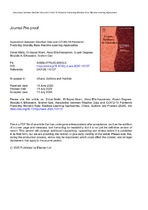Mostrar el registro sencillo del documento
Association between weather data and COVID-19 pandemic predicting mortality rate: Machine learning approaches
| dc.creator | Malki, Zohair | |
| dc.creator | Atlam, El-Sayed | |
| dc.creator | Hassanien, Aboul Ella | |
| dc.creator | Dagnew, Guesh | |
| dc.creator | Elhosseini, Mostafa A. | |
| dc.creator | Gad, Ibrahim | |
| dc.date.accessioned | 2020-07-27T22:18:31Z | |
| dc.date.available | 2020-07-27T22:18:31Z | |
| dc.date.created | 2020-09 | |
| dc.identifier.issn | 0960-0779 | spa |
| dc.identifier.other | https://www.sciencedirect.com/science/article/pii/S0960077920305336?via%3Dihub | spa |
| dc.identifier.uri | http://hdl.handle.net/20.500.12010/11249 | |
| dc.format.extent | 15 páginas | spa |
| dc.format.mimetype | application/pdf | spa |
| dc.publisher | Chaos, Solitons and Fractals | eng |
| dc.source | reponame:Expeditio Repositorio Institucional UJTL | spa |
| dc.source | instname:Universidad de Bogotá Jorge Tadeo Lozano | spa |
| dc.subject | Aprendizaje automático | spa |
| dc.title | Association between weather data and COVID-19 pandemic predicting mortality rate: Machine learning approaches | spa |
| dc.type.local | Artículo | spa |
| dc.subject.lemb | Síndrome respiratorio agudo grave | spa |
| dc.subject.lemb | COVID-19 | spa |
| dc.subject.lemb | SARS-CoV-2 | spa |
| dc.subject.lemb | Coronavirus | spa |
| dc.rights.accessrights | info:eu-repo/semantics/openAccess | spa |
| dc.type.hasversion | info:eu-repo/semantics/acceptedVersion | spa |
| dc.subject.keyword | OLS | spa |
| dc.subject.keyword | Temperature | spa |
| dc.subject.keyword | Humidity | spa |
| dc.subject.keyword | Machine learning | spa |
| dc.subject.keyword | Prediction | spa |
| dc.identifier.doi | https://doi.org/10.1016/j.chaos.2020.110137 | spa |
| dc.description.abstractenglish | Nowadays, a significant number of infectious diseases such as human coronavirus disease (COVID-19) are threatening the world by spreading at an alarming rate. Some of the literatures pointed out that the pandemic is exhibiting seasonal patterns in its spread, incidence and nature of the distribution. In connection to the spread and distribution of the infection, scientific analysis that answers the questions whether the next summer can save people from COVID-19 is required. Many researchers have been exclusively asked whether high temperature during summer can slow down the spread of the COVID-19 as it has with other seasonal flues. Since there are a lot of questions that are unanswered right now, and many mysteries aspects about the COVID-19 that is still unknown to us, in-depth study and analysis of associated weather features are required. Moreover, understanding the nature of COVID-19 and forecasting the spread of COVID-19 request more investigation of the real effect of weather variables on the transmission of the COVID-19 among people. In this work, various regressor machine learning models are proposed to extract the relationship between different factors and the spreading rate of COVID-19. The machine learning algorithms employed in this work estimate the impact of weather variables such as temperature and humidity on the transmission of COVID-19 by extracting the relationship between the number of confirmed cases and the weather variables on certain regions. To validate the proposed method, we have collected the required datasets related to weather and census features and necessary prepossessing is carried out. From the experimental results, it is shown that the weather variables are more relevant in predicting the mortality rate when compared to the other census variables such as population, age, and urbanization. Thus, from this result, we can conclude that temperature and humidity are important features for predicting COVID-19 mortality rate. Moreover, it is indicated that the higher the value of temperature the lower number of infection cases. | spa |

